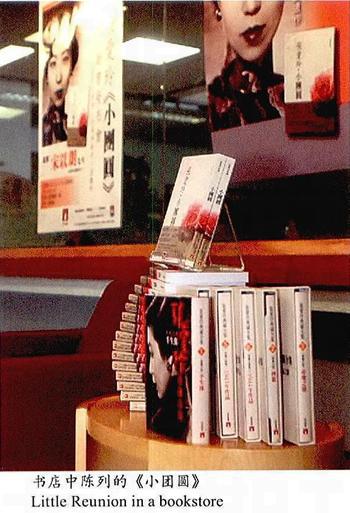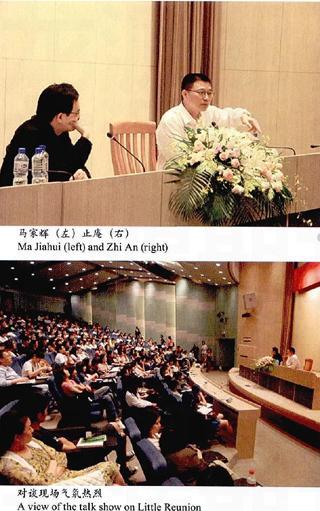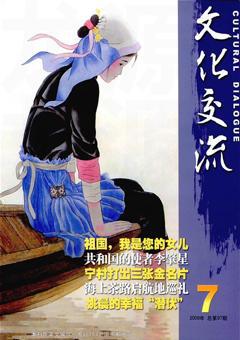“Little Reunion” and Eileen Chang
By Qi Yongye


“Little Reunion” by Eileen Chang (1920-1995) was published on the Chinese mainland in April, 2009. For readers who know about Changs short-lived marriage with Hu Lancheng in the 1940s, Little Reunion, a fiction but generally viewed as an autobiographical one, reminds readers of the love-hate relationship between the two.
Many readers wonder why it was published in 2009, more than 10 years after the demise of the writer and more than 30 years after the novel was first penned.
Stephen Soong and his wife Mae Fong Soong were Eileen Changs friends for decades. They acted as Changs advisors and literary agents. Stephen Soong, a prominent translator and scholar in his own right, often advised Chang on her works. In 1961, Eileen Chang came to Hong Kong and wrote two plays in order to raise some money to pay for her American husband Ferdinand Reyhers medical bills. She stayed with the Soongs. She shut herself in a small room writing day and night. The room had a bed, a desk, and a chair. After Chang went back to America, the room was converted into a bathroom. Years later, some enthusiasts of Eileen Chang requested to see the room where Eileen Chang once stayed. The Soongs showed them the bathroom.
Shortly before her death, Eileen Chang asked her legal representative to send all of her manuscripts to the Soongs. “Little Reunion” was in the manuscripts.
In 1996, Stephen Soong passed away and in 2003 his wife had a stroke and died in 2006. All the manuscripts were transferred to Roland Soong, their son. It was not until this time that the son realized that his mother had taken all the responsibility for Eileen Changs manuscripts and published works. It was the first time the son became aware of the existence of “Little Reunion”.
He read the 628-page fiction at one sitting. He knew he was not the only one in this world who knew the existence of the novel and knew the novel was based on real history. The manuscripts looked clean, with few editing marks. He concluded that it was a new copy the writer made after the manuscript was completed. Though Roland Soong knew Eileen Chang wished to have the novel destroyed, he told himself that the writer had committed herself to the work and he would by no means have it destroyed.
In order to understand why the book had been shelved for such a long time, Roland Soong went through more than 600 letters between Eileen Chang and his parents over the past 40 years. He figured out why it had not been published.
Chang began to write the novel in 1970 at the age of 49, twenty years after the divorce between her and Hu Lancheng. By that time, her American husband had already passed away. It was her time to write an autographical novel. The novel was completed in 1976. Chang sent a copy to Stephen Soong in the hope that it could be published in Hong Kong and Taiwan. Chang also hoped to have part of the novel serialized in newspapers over a period of several months to attract more readers.
Soong advised Chang not to publish the novel on the grounds that the novel would have given Hu Lancheng an opportunity to talk in Taiwan since Chang was a celebrated writer and her life story was well known among readers. Hu Lancheng was teaching in Taiwan and many people thought he should be disqualified because of his past experience as a traitor in collaboration with the Japanese. The novel would link Chang with Hu Lancheng, which would have ruined Changs reputation in Taiwan.
Soong advised Chang to make some changes about the identity of the hero in the novel so that there would be no excuse for Hu Lancheng to say he was the prototype of the man in the novel. Chang replied that she could not make changes as advised. It was not merely about Hu Lancheng who collaborated with Japanese during the War. It was also about the history of her mothers family and that of her paternal aunts. Chang was apparently concerned that peoples interest in the romance between her and Hu Lancheng would devalue the literary significance of her novel. She wanted to destroy the novel herself. But she did not have the heart to do it. She was of two minds about the novel for a long time. In 1993, she wrote to her Taiwan publisher Ping Xintao mentioning that she would complete “Little Reunion” as soon as possible to keep her promise to her readers. In her will, Chang said that the manuscript should be destroyed and that the book should not be published.
“Little Reunion” became a bestseller as soon as it was published. Someone even compared it to the Chinese counterpart of “Remembrance of Things Past” by Marcel Proust. For many readers on the mainland, Eileen Changs novels and her individual life are their collective memory of their own youth and something they can share with their contemporaries. This is probably why the novel is such a hit on the market.
The story relates the story of a female writer Jiuli. In her childhood years she experiences the ups and downs when an old era was being pushed out and a new era was being ushered in. A child of a traditional family, she meets all kinds of classmates in her monastery school. She meets with a married traitor. Her emotional struggle does not ease through the elapse of time. Her emotional entanglement with the man creates turmoil and anxiety in her heart and soul. Experienced readers can easily understand that Jiuli, unlike women in Changs other stories, is Chang herself.
Many readers read “Little Reunion” and compare Changs life with the novel. Some sympathize with Eileen Chang and loathe Hu Lanchengs notorious infidelity. Some believe Chang is narrow-minded. For some outsiders, love excuses anything. But what alternatives would one have if one were entangled in such a love like that of Eileen Chang? Outsiders have no way to find out what is right and what is wrong when there are so many versions of truth.□

